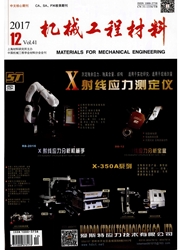

 中文摘要:
中文摘要:
分别对5mm厚的普通铸轧和电磁超声(电磁场和超声波共同作用)铸轧AZ31B镁合金板进行相同工艺的多道次温轧,制备出1.3mm厚的薄板;对比分析了两种终轧薄板的显微组织和织构,并在175-300℃的温度范围内采用平底杯形冲头进行拉深试验,研究了成形温度对两种终轧薄板热拉深性能的影响。结果表明:电磁超声铸轧的终轧薄板的平均晶粒尺寸为lO~12μm,普通铸轧的终轧薄板平均晶粒尺寸为14~16μm;电磁超声铸轧与普通铸轧的终轧薄板相比,基面织构取向密度较低,锥面和棱柱面织构取向密度较高;电磁超声铸轧的终轧薄板热拉深性能在175-300℃均优于普通铸轧的,且在250℃左右极限拉深比(LRD)达到最大2.0,此时普通铸轧终轧薄板的LRD为1.875。,
 英文摘要:
英文摘要:
AZ31B Mg alloy sheets with thickness of 5 mm deformed by general cast rolling and by electromagnetic field and ultrasonic field cast-rolling, were rolled by multi-passes to get the sheets with thickness of 1. 3 mm. The microstructure and textures of two kinds of ultimate sheets were comparatively analyzed. Furthermore, deep drawing test for Mg alloy ultimate sheets was carried out in a temperature range between 175 C and 300℃. Effect of forming temperature on deep hot deep drawing properties of two kinds of sheets was investigated. Results show that the average grain diameter of Mg ultimate sheet cas~rolled in electromagnetic field and ultrasonic field was 10-12μm, while that of general Mg ultimate sheet was 14-16μm. In contrast to general cast-rolling Mg ultimate sheet, basal plane texture of electromagnetic field and ultrasonic field cast rolling Mg ultimate sheet had a lower orientational density, but the conical plane texture and cylinder plane texture of that had higher orientational densities. Hot deep drawing property of electromagnetic field and ultrasonic field cast rolling Mg ultimate sheet with the maximum limiting drawing ratio of 2. 0 at 250 ℃was superior to that of general cast rolling Mg ultimate sheet with the maximum limiting drawing ration of 1. 875 at 250 ℃ in a temperature range between 175 ℃ and 300 ℃.
 同期刊论文项目
同期刊论文项目
 同项目期刊论文
同项目期刊论文
 期刊信息
期刊信息
